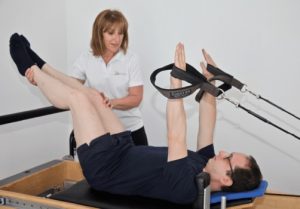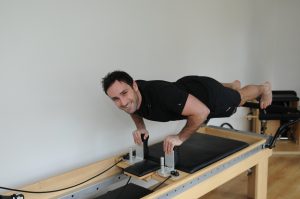An exercise regimen first developed for rehabilitation in the early 20th century, in its clinical application, Pilates focuses on core stabilisation, posture and biomechanical symmetry going beyond the concepts that form the basis of most orthopaedic rehabilitation. It has become a powerful rehab tool with significant benefits for patients as well as for Sports Performance enhancement.
Its focus on movement and breathing brings new and effective treatment methods. It’s also extremely versatile – the extensive exercise repertoire is modified to fit the needs of each patient.
The Pilates principle of core stabilisation addresses posture, muscle performance and motor control – the same concepts that form the basis of most orthopaedic rehabilitation and therapy. As well as assisting with rehabilitation following injury or surgery, Pilates is being used successfully to treat many common conditions including:
- Chronic neck and back pain
- Sciatica
- Shoulder impingement/tendonitis
- Slipped disc
- Hip bursitis
- Ankle injuries
- Total knee/hip replacements
- Multiple Sclerosis
- Parkinson’s Disease
- Fibromyalgia
- Scoliosis
as well as to elite, professional and amateur sportspeople keen to achieve maximum performance in their discipline.
Rehabilitation Pilates is offered in Jane’s specially built clinic, where patients experience rehabilitation and performance therapies based on clinical Pilates exercises both using the leading Pilates apparatus (Reformer) and mat-based disciplines.
The most commonly used machine is the Reformer - originally invented by Joseph Pilates and looking like a cross between a bedstead and a medieval torture device! The Reformer has a flat platform which is attached to one end of the frame by a set of springs set to differing levels of resistance according to the patient’s body weight and capabilities. This allows the patient to lay in position on the platform and roll back and forth by applying pressure either to a foot bar or by using legs or arms through a series of straps. The exercises can be done lying down, sitting, standing, and with the addition of supplementary attachments the therapist can address many parts and dynamics of the body, but always ensuring the patient’s body is fully supported and in the correct position for the type of exercise.
If you have injured yourself and are considering Pilates, it is important to ensure that your instructor has clinical physical therapy experience. There is a great difference between Pilates as a way of exercising – how most people have encountered the technique – and applying it as form of therapy.
The principles of Pilates are ideal for rehabilitation, but if they aren‘t used in conjunction with proper clinical diagnosis and therapy techniques it could do more harm than good which is why Jane’s clinical approach is so effective.
Conversely, physical therapy techniques may prove inappropriate on their own as the exercises may be too hard for the patient or may cause too much pain, or -very often- the patient’s body awareness is not adequate to enable them to achieve maximum results – something that Pilates teaches you to do. That is why, as a fully qualified sports therapist working with Pilates, Jane creates combinations of Pilates disciplines with appropriate modalities and techniques of sports therapy to provide the most effective combination for each individual patient.


If at the age of 30 you are stiff and out of shape then you are old.
If at the age of 60 you are supple and strong then you are young.
- Joseph Pilates
How does Clinical Pilates exercises work?
Jane’s own internationally recognised research supports the value of clinical Pilates
Jane spoke at the 10th Interdisciplinary Global Congress on Low Back Pain, a major international medical congress held in Antwerp in the autumn of 2019. She presented her ground-breaking research on the benefits of Pilates exercises to combat low back pain which concluded that clinicalPilates is suitable for both specific and non-specific conditions and that patients be prescribed Pilates exercise-based therapy programmes conducted ideally on machines in a clinical environment, with a prescribed regularity of once or twice a week.
To see case studies of clinical Pilates in Jane’s clinic watch the videos:
Pilates Testimonials
I suffered from a prolapsed back disc and sciatica and was off for work for over a year….I was introduced to Jane through a friend and my improvements were almost immediate. Jane’s methods pushed me but were also strangely relaxing! I had never used Pilates before but Jane’s guidance mixed with her Indiba (radio frequency) therapy allowed me to progress weekly and the results were staggering. I still use the techniques Jane taught me just to stretch my back out and keep a strong core. I am now back to playing rugby and cycling and looking at completing a cycle ride up Mont Ventoux …which was one of my goals when I first met Jane.Marcus J
I have been an avid fan of Jane's machine-based Pilates for two and half years now. She is very professional, very friendly and a real perfectionist which I love. The Pilates has helped to relieve my low back pain problems, the trapped nerve problem in my neck that caused numbness in my right hand and improved my posture. All in all, fantastic! …. she has more qualifications than you could remember.AB
Sessions from £50, multiple session packages available
